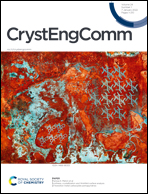Structurally characterised new twisted conformer for cyclen, controlled by metal ion complexation as seen in NiII and CuII complexes with halides and pseudohalides†
Abstract
Serendipitous self-assembly is a potential approach for achieving structurally versatile and unexpected solids with chosen metal–ligand combinations. Cyclen (1,4,7,10-tetraazacyclododecane) is an interesting flexible molecule, well explored for biological and material applications of its metal complexes. The dihedral angle (θ) between four nitrogen atoms of free cyclen is close to 0°. Still, it may vary upon complexation, allowing flexibility to adopt any two conformers, viz., (i) planar and (ii) twisted. The present work establishes the crucial role of metal ions in controlling the conformation adopted by cyclen through metal complexation. SCXRD studies of the complexes of cyclen with CuII and NiII with halides and pseudohalides as counterions reveal the existence of a planar conformation (θ = ∼0–3°) for cyclen in CuII systems and a highly twisted conformation (hitherto unreported) in NiII systems (θ = ∼52–55°). Further, SQUID magnetic studies for the dimeric [Ni1] complex reveal antiferromagnetic interactions between the two Ni centres.



 Please wait while we load your content...
Please wait while we load your content...